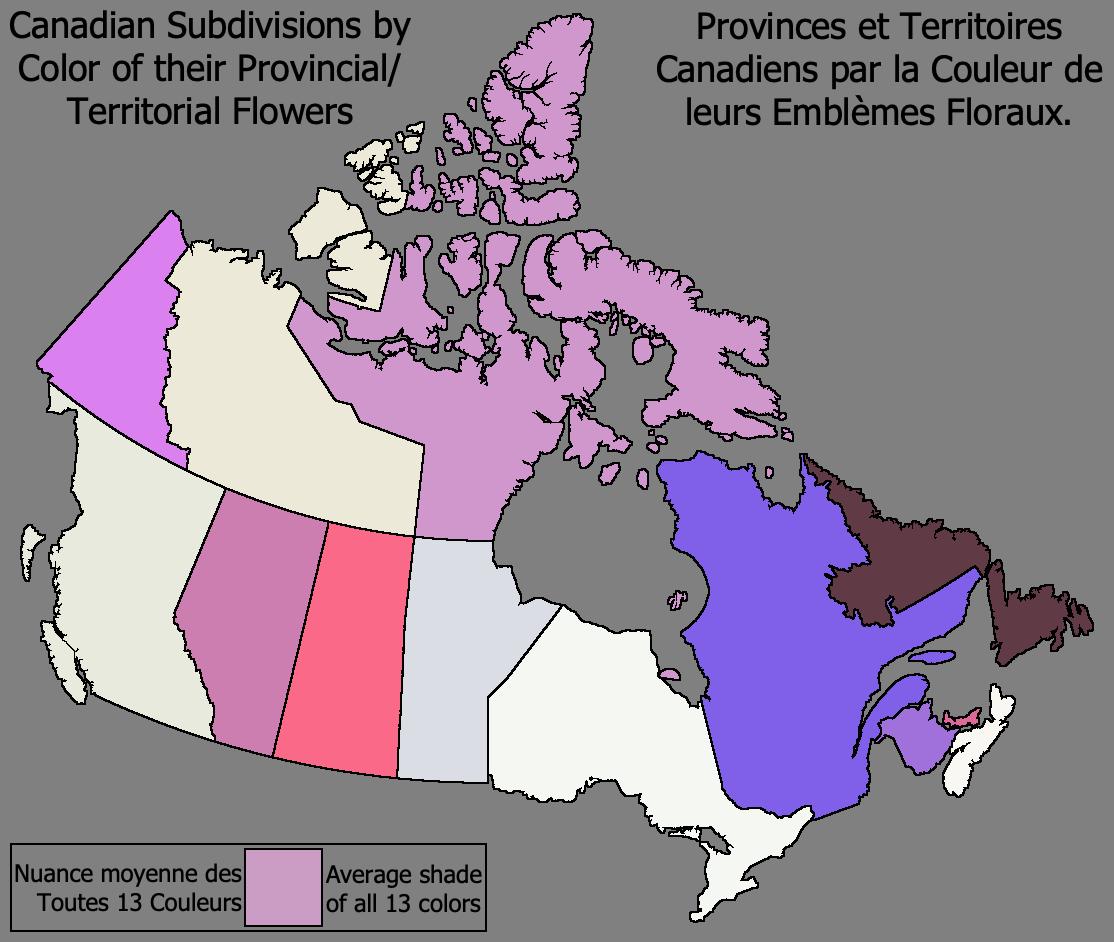Map of Canada by Provincial Flower Color


David Chen
Data Visualization Specialist
David Chen is an expert in transforming complex geographic datasets into compelling visual narratives. He combines his background in computer science ...
Geographic Analysis
What This Map Shows
This captivating map visually represents Canada through the colors of each province's and territory's floral emblem. Unlike many nations that boast a singular national flower, Canada celebrates a rich tapestry of floral diversity at the provincial level. Each flower not only embodies the unique identity of its region but also reflects the natural beauty and cultural heritage of Canada. In the lower left corner of the map, you'll find the average color calculated from all the provincial flowers, offering a fascinating glimpse into the collective floral palette of the nation.
Deep Dive into Provincial Flowers in Canada
Canada's provinces and territories each have designated floral emblems that resonate with their local landscapes and cultural narratives. Interestingly, the choice of flowers often corresponds with the climate, geography, and history of the region. For example, the **British Columbia** provincial flower, the Pacific dogwood (Cornus nuttallii), is a stunning symbol of the coastal region, thriving in the temperate rainforests. Its creamy white petals stand out against the vibrant greens of the forest, embodying the natural beauty of the province.
In stark contrast, **Alberta** embraces the wild rose (Rosa acicularis), a resilient flower that flourishes in the province's grasslands and foothills. The soft pink hue of the wild rose adds a touch of warmth to Alberta's rugged terrain, reflecting the spirit of its inhabitants.
The floral diversity doesn't stop there. Moving east, **Ontario** has chosen the trillium (Trillium grandiflorum), which showcases a distinctive three-petaled white flower that carpets the forest floors in springtime. Its iconic status not only emphasizes Ontario's rich biodiversity but also highlights the importance of conservation efforts to protect these delicate ecosystems.
Each flower contributes unique colors to the overall visualization, leading to an intriguing exploration of floral representation across Canada. For instance, the yellow of the **Manitoba** provincial flower—goldenrod (Solidago)—stands out brightly on the map, symbolizing the sunny fields and prairie landscapes of the region. The variety of colors ranges from the deep reds of **Nova Scotia's** mayflower (Epigaea repens) to the soft blues of the **Yukon's** fireweed (Chamerion angustifolium), showcasing not only the floral diversity but also the climatic differences across the country.
Regional Analysis
Examining the map closely reveals fascinating regional trends and variations. In **Western Canada**, for instance, many provincial flowers lean towards warm hues—reds, yellows, and pinks—reflecting the vibrant wildflowers that flourish in the region's diverse ecosystems. The **Prairies**, with their vast open landscapes, feature flowers such as the prairie crocus (Anemone patens) in **Saskatchewan**, symbolizing resilience and beauty amidst the often harsh climatic conditions.
Conversely, the **Eastern provinces** tend to showcase a cooler color palette. The soft whites and blues of flowers like the **Newfoundland and Labrador's** pitcher plant (Sarracenia purpurea) and **Prince Edward Island's** lady's slipper (Cypripedium acaule) highlight the lush, moist environments of the region. This contrast not only makes for an aesthetically pleasing map but also reflects the ecological diversity found across Canada’s landscapes.
Significance and Impact
Understanding the significance of provincial floral emblems goes beyond mere aesthetics; it connects us to the natural and cultural heritage of each region. Flowers often symbolize local traditions, historical events, and even narratives of resilience and adaptation. For example, the **Northwest Territories'** choice of the mountain avens (Dryas integrifolia) as their floral emblem showcases the hardiness of nature in the face of extreme conditions, reminding us of the importance of environmental conservation.
As we navigate through climate change and ecological challenges, these floral emblems serve as vital reminders of the unique biodiversity that each province contributes to the larger Canadian ecosystem. The varying colors on the map not only represent flowers but also symbolize the provinces' identities and their connection to the land. Interestingly, as climate patterns shift, we may also see changes in these floral emblems, prompting questions about future conservation efforts and the adaptation of regional identities.
In conclusion, Canada’s provincial and territorial flowers present a vibrant and dynamic representation of the nation’s ecological and cultural diversity. This map invites viewers not only to appreciate the beauty of these flowers but also to reflect on their significance in the broader context of geography, identity, and conservation in Canada.
Visualization Details
- Published
- August 11, 2025
- Views
- 120
Comments
Loading comments...